Matador Network's Blog, page 595
September 7, 2021
Everything you need to know to visit Kenya for the first time
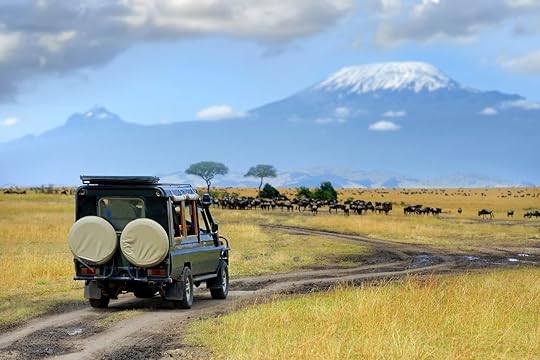
Touching down on a makeshift airstrip at the Maasai Mara National Reserve and being met by herds of wildebeest and zebras grazing languidly along the grassy plains is an experience that will stay with you for years to come. These sights are part of the once-in-a-lifetime adventure that draws people from around the world to the birthplace of safaris: Kenya.
Though best known for its wildlife-rich parks and preserves, there’s more to Kenya than scouting for the Big Five. With topography ranging from the craggy, snow-capped peaks of Mount Kenya, to the expansive grassy plains of the Maasai Mara, the warm and sandy shores of Lamu, and even to the urban jungle of Nairobi, no two regions of Kenya are alike. With so many options, it may be difficult to decide where to start, what to do, and how much time to allot for each magical experience when visiting Kenya. We’re will help you plan your trip.
How much time to spend visiting Kenya?
Wendy Hu
A week in Kenya is doable, but two weeks is ideal, especially if you plan to adventure throughout different cities in the country. Due to COVID-19, many domestic flights are still limited within Kenya. Couple that with long drive times due to the remoteness of many of the lodges and accommodations, and you’ll find that traveling within Kenya usually results in an all-day affair. So be sure to factor in travel days when planning your trip.
Top things to do when visiting KenyaWhether you are looking to take a luxurious romantic getaway, an eco-friendly sabbatical in the bush, or a family-friendly adventure, you won’t find a shortage of things to do to suit your tastes while in Kenya. If you’re making the voyage to Kenya, chances are, a safari or two will be on your list of things to do. With over 40 national parks and reserves and over 160 conservancies, choosing which ones to visit can be a daunting task. To help narrow it down, here are two safari lodge camps that have completely different vibes, but that offer equally incredible experiences.
Stay at a sustainable eco-lodge and do walking safaris
Wendy Hu
El Karama Conservancy is a private, family-owned conservancy committed to supporting biodiversity through holistic management and sustainability. The private lodge is located in Laikipia, at the foothills of Mount Kenya. With a sprawling 14,000 acres of private land and views of over 200,000 acres, El Karama is one of the most magical habitats in Laikipia. Here, predators and a gamut of endemic and endangered species roam wild and free. You will see your fair share of zebra, giraffe, elephants, and antelope during your game drives, and if you’re lucky you may even spot lions, leopards, and cheetahs. Morning bush walks give you an up-close-and-personal lay of the land and, by the end of your expedition, you’ll be able to spot and name a myriad of flora, fauna, and even animal defecation.
Splurge on a luxury lodge experience
Wendy Hu
Mara Plains Camp re-opened recently after undergoing a full renovation. This wildlife destination is tucked within the Olare Motorogi Conservancy, with access to over 100,000 acres of exclusive land in addition to the 583-square-mile Maasai Mara Reserve. This lodge offers a luxury, five-star safari experience with all the bells and whistles, like complimentary Canon DSLR cameras with telephoto lenses for your use. The landscapes here offer a flatter, less bushy terrain, making it easier to spot those elusive predators, like the big cats. During my trip to the Maasai Mara, I saw wildebeest, lions, and even a mama leopard with her four cubs. Peak season for the Maasai Mara is July to October when over two million wildebeest, zebra, antelope and other herds of animals make their annual migration.
Sleep under a blanket of stars
Wendy Hu
For an unforgettable experience during your time in Kenya, spend at least one night sleeping under the stars. A “Fly Camping” experience can easily be arranged with El Karama Lodge during your stay. Sundowners by the fireside, open-fire cooking, the sounds of nature and wildlife serving as a calming soundtrack all create a bespoke experience for the books. When it’s time to turn in for the night, you have the choice of curling up in a bell tent or Tentsile tree tents. The latter is perfect for families with adventurous children, as these fun tents are suspended in the trees.
Get a bird’s eye view of the Maasai Mara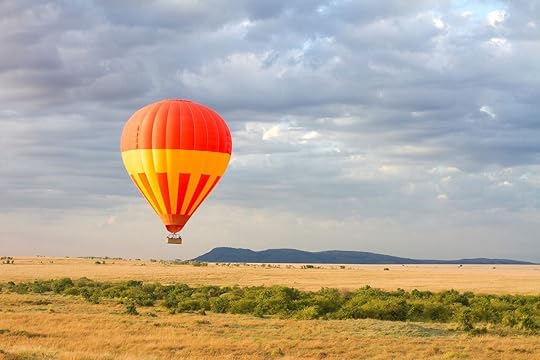
Photo: Balloon Safaris/Facebook
When planning your trip to Kenya, the one thing you may not have considered is experiencing a safari from a different vantage point. If a hot air balloon safari ride above the Maasai Mara isn’t on your bucket list, now’s the time to add it. Soaring high above the plains you light spot a lioness sauntering across the savanna, a lone elephant standing as though it’s posing for a photo, and more wildebeest, antelope, and zebra than you can count. If you book a tour with an operator like Balloon Safaris Limited, your day will start long before sunrise, but watching it wake from its slumber and paint the morning skies a peaceful palette of pastels, you’ll soon forget about the nominal sleep you got the night before.
Watch baby sea turtles hatch
Photo: Lamu Marine Conservation Trust/Facebook
You will have to make your way to the coast for this, and your timing will have to be perfect. However, if you are able to time it just right, you’ll get to witness one of the most incredible — and dare I say cutest — sightings while in Kenya. Endangered green turtles are finding refuge in Lamu thanks to the Lamu Marine Conservation Trust. During my trip to Lamu, we were able to witness ex-poachers, who are now hired to protect turtles’ nests, facilitate a new batch of hatchlings making their way to the sea to begin their life voyage.
How to travel to and within KenyaNow that you have an idea of what you want to do when you are in Kenya, let’s talk about how to actually get there, and get around once you’re in the country. Unless you are flying directly to the coastal regions of Kenya, you will likely be flying into Nairobi’s Jomo Kenyatta International Airport.
Quite possibly the most luxurious way to get there is via Qatar Airways Qsuites — one of the world’s best business-class suites. These suites come with a hefty price tag; however, with dining on demand, your own private pod with a door that closes, and your own personal flight attendant, the long-haul flight in these premier suites are an unforgettable experience of their own. You will be able to get a good night’s rest with Qatar’s turn-down service and seats that recline fully into a bed. Qatar even provides comfy pajamas and a travel kit containing several toiletry essentials.
Once you touch down in Kenya, there are several ways to get around. We don’t recommend driving, unless you are familiar with the driving culture in Africa and you have impeccable map-reading skills along with a keen sense of direction. Many of the conservancies and reserves are located in extremely remote areas, where no signage or lights exist. Besides that, you will need an off-road vehicle to get you down the pothole-riddled dirt roads.
The best and safest option for getting around on the ground in Kenya is through a private driver, an organized tour, or by booking accommodations that also provide transportation. If you are traveling to different areas within the country, the quickest, though not the most affordable, way to get around is by a domestic airline, like SafariLink. These flights depart from Wilson Airport, about four miles from Nairobi city center.
When flying domestic airlines, you will have to abide by strict weight restrictions, maxing out at 33 pounds total for your checked luggage and hand luggage. Since domestic flights are on smaller aircrafts — think 16-seater aircrafts — soft-sided duffel bags are strongly recommended as space is extremely limited. Also note, plastic bags, such as grocery bags, are prohibited in Kenya, and being caught with them could result in a fine if found in your possession.
What to pack and what to wear in Kenya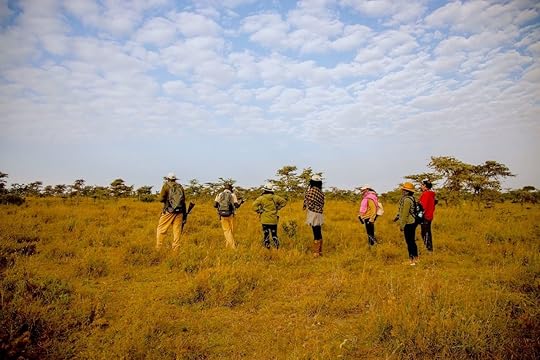
Wendy Hu
Given the space limitations, not only on the aircrafts but also on the safari vehicles, you’ll want to ensure you are packing all the things you need and none of the things you don’t.
The Maasai Mara is on a plateau, with an elevation of around 5,000 to 7,000 feet — temperatures are cool, averaging from low 50’s Fahrenheit in the mornings to high 70’s by midday in areas like Nairobi, Laikipia, and Great Plains — so packing layers is highly recommended. Fifty degrees may not seem all that chilly until you’re riding in an open-air vehicle with gusting winds. It gets quite cold, so you’ll want to pack a jacket and perhaps even a knit cap for those frigid mornings.
Muted tones that blend into nature, like tans, browns, and dark greens, are highly recommended. Steer clear of bright colors, especially red, as you don’t want to alarm any of the animals. If you’re thinking about donning camouflage, don’t — it’s actually illegal to wear this pattern in Kenya if you are not military personnel. If you’re doing a bush walk during your stay, boots are the way to go. Sneakers will suffice; however, when meandering through tall prickly grass, boots are better.
The coastal regions and rural areas in Kenya will be much warmer, averaging in the mid 80s to low 90s. However, these regions are predominantly Muslim so dress is far more conservative. It is culturally appropriate for women to cover their upper arms and legs, and avoid low-cut tops.
More information on visiting Kenya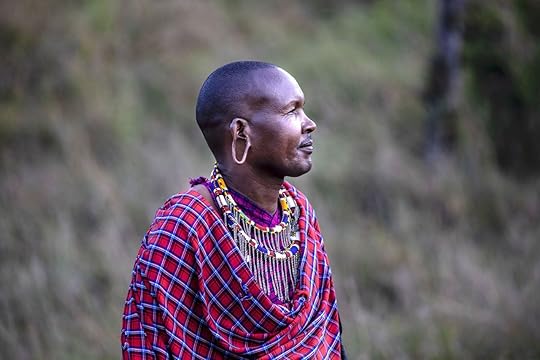
Wendy Hu
There are around 42 ethnic groups in this country, making the culture just as unique and diverse as its terrains. One thing that remained consistent on my travels there was the warmth of every Kenyan I met. From the incredible guides, to the Masai warriors, and friendly passerbyers belting “Jambo!” (hello), the kindness exuded is unmatched.
There’s also no such thing as a “stranger” in Kenya — or, at least, there’s no literal translation of that word. Instead, “mgeni” is the closest word you’ll find. It means guest or visitor — and in Kenya, everyone is treated as such. This ethos runs deep. You’ll find that many homes, especially in coastal regions like Lamu, have an outdoor sitting nook in front of them. These sitting areas are open to anyone, whether you are a “stranger” just passing through or a family friend.
As a guest in Kenya, there are a few things to keep in mind. Ask for permission before taking photos of anyone — particularly in the villages and rural towns, and especially of women and children. Our guide advised us that you may encounter those who are friendly and welcome having their photos taken. However, there are others who, even if they sense you picking up your camera to snap a photo, they will shun the camera or may become aggressive.
A few words to know when visiting KenyaLearning a few of local words goes a long way in showing your respect for the place you are visiting, no matter where you travel. Swahili, alongside English, is the official language in Kenya. As mentioned, “jambo” is the most common greeting you’ll hear in Kenya. It isn’t one of those flat “hello” greetings uttered just as a courtesy. On the contrary, jambo is said in almost a singsong manner. It’s full of cheer and feels like sunshine when it’s exchanged. So, when walking down the streets of Kenya, or bopping into local shops, and your new stranger friend greets you with, “Jamboooo”, be sure to return the same enthusiasm.
Another word to know when traveling to Kenya is “asante” or “asante sana.” This means thank you or thank you very much. When someone thanks you, you can in turn say karibu, which is you’re welcome. Use “pole pole” when you’re on safari and you’d like the driver to slow down. The translation means to take it easy. Another phrase to keep in mind, whether adventuring in Kenya or simply journeying through life is “hakuna matata” — a phrase we all know so well — meaning no worries or no problems.
What to tip in KenyaWhen it comes to tipping culture in Kenya, there is an expectation in the hospitality industry; however, it is, of course, to your own discretion. Kenya Shillings (KES) is the local currency and US dollars are often accepted within the tourism sector. Here are a few suggestions for tipping:
Tour guides and drivers: 1,500 KES (approximately $15 USD) to each guide and driver per day
Waiters and bar staff: 500 KES
Baggage porters: 500 KES
In this new age of nasal swabs and QR codes, be prepared to show both upon arrival in Kenya. Proof of a negative COVID PCR test, valid for 96 hours from the date the test is taken till your arrival in Kenya, is required. In addition, COVID test results must be uploaded on Trusted Travel or Global Haven websites where you’ll be given a QR code that you must show, along with your negative COVID test upon arrival. You will also have to complete an online International Travelers Health Surveillance Form where you’ll get another QR code that must be printed and shown on arrival.
If you are a US citizen, you will be required to have a visa for entry, which costs US $51. All other citizens can check visa requirements through Kenya’s Immigration Department. 
The post Everything you need to know to visit Kenya for the first time appeared first on Matador Network.
Experience the history of southern food at these Airbnb cooking experiences

Experiencing the culture of Southern food is an undeniable part of any proper trip to the South. There are cities with world-class restaurant scenes, like Atlanta and Charleston, South Carolina, but some of the most memorable dining experiences can be had at private events hosted by top-notch chefs. Experience the best of Southern cooking at these Southern food Airbnb experiences.
We hope you love the spaces and stays we recommend! Just so you know, Matador may collect a small commission from the links on this page if you decide to book a stay. Listed prices are accurate as of the time of publication. See our full Advertiser Disclosure here.
Dine on Southern cuisine at a Lowcountry estate on Wadmalaw Island
Photo: Airbnb
JJust southwest of Charleston is Wadmalaw Island, an area that doesn’t typically garner glossy headlines or attract the same acclaimed chefs as the Holy City, but is a great place to dine nonetheless. This Southern food Airbnb experience is proof. You’ll gather at the expansive Ruby Ranch where a cocktail, beer, or glass of wine awaits. Grab it, then walk down to the dock to watch the waves roll in from the Atlantic as the sun sets behind you. Afterward, you’ll take part in a three-course dinner prep while learning the history of the recipes, the ingredients, and the presentation. Dishes frequently include shrimp and crab caught just offshore from the ranch.
Weather permitting, you’ll dine outside — though the indoor setup is equally appealing. Host Cheryl is a long-time chef and hospitality industry professional who takes pride in showcasing her family’s recipes. Classes are offered seasonally and aren’t always available, but this cooking experience is worth building a trip around. Check the listing for upcoming dates.
Price: $125 per person
An evening of Lowcountry food, drinks, and music in Charleston
Photo: Airbnb
This Southern food Airbnb experience is a full-circle private event. Chef Christopher is as experienced in the kitchen as any in Charleston, and he can prove it. Not just through his Lowcountry cuisine, but with cocktails, wine, and music to match. The result is a four-course wine dinner that epitomizes Charleston’s famous food culture. Local ingredients shine at these dinner experiences at The Laundry Room in Charleston on Friday and Saturday nights. Drinks and food are included in the three-hour event, as is good conversation and the chance to learn from a Charleston legend.
Price: $150 per person
Learn to cook Smothered Shrimp and Grits in Atlanta
Photo: Airbnb
Rashaad Spears has been an executive chef for more than 10 years. Now, he leads the most engaging cooking class in Atlanta almost daily. You’ll join him in his kitchen to prepare authentic smothered shrimp and grits with an appetizer of fried green tomatoes. You’ll learn about the food and culture as you assist the chef in putting everything together. And then, of course, you dine on what is sure to be one of the most, if not the most, memorable meal of your time in Atlanta.
Spears provides all ingredients and cooking utensils, but you may want to bring a notebook to jot down tips and tricks so that you can attempt to recreate what you learn back home. The cooking class runs from 6 to 8 PM and costs $72 per person, or $180 for a small group.
Price: $72 per person/$180 per group
Cook along from home with chef Nick Wallace’s Southern Soul Food Cooking Course
Photo: Airbnb
Even if you aren’t located in the South and won’t be traveling there anytime soon, you can still take part in the action through online Southern soul food cooking experience. Chef Nick Wallace leads the experience from his Mississippi farm and walks you step-by-step through a full meal (and then some) that you prepare in your own kitchen. On the menu is Wallace’s celebrated braised collard greens, creamy grits, onion preserve, fried catfish, and cornbread. Wallace also walks you through the history of the dishes and how his family learned to cook them.
The class takes place live on Zoom and can fit up to 10 people. Even if you opt not to cook, you can watch along and take notes as Wallace prepares each dish, and then you have the recipes for future use. 
Price: $30 per person
The post Experience the history of southern food at these Airbnb cooking experiences appeared first on Matador Network.
5 incredible Alabama adventures
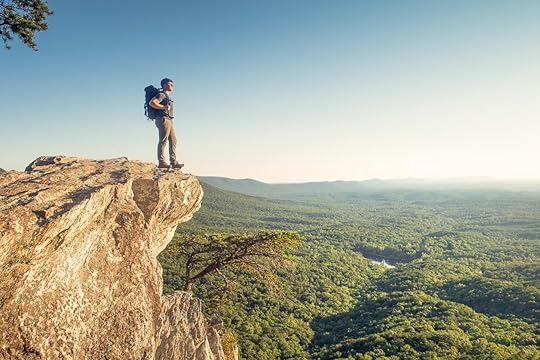
From caves to coastline, from foothills up to dramatic waterfalls, the adventures on offer in Alabama will put your closet full of outdoor gear to good use. It’s just about guaranteed you’ll leave with a greater appreciation for nature, a little bit of a Southern drawl, and a full belly — thanks to small-town restaurants serving up fresh-caught seafood, homegrown vegetables, and from-scratch desserts. Here’s what’s in store on your next trip to Alabama.
1. Getting in touch with nature in Mentone
Photo: Alabama Travel
Only a few minutes’ drive from the Georgia-Alabama border in the state’s northeast lies Mentone, a tiny town of about 300 people backdropped by the southern Appalachian Mountains. (In fact, it’s home to Alabama’s only ski slope: Cloudmont Ski and Golf Resort.)
Three miles from town, DeSoto State Park is where you’ll find DeSoto Falls, a mesmerizing 104-foot waterfall cascading into a cliff-lined pool. Drive just another 15 minutes south to reach Little River Canyon National Preserve and try forest bathing (immersing yourself mindfully amongst the trees) or enjoy a picnic. Pitch a tent or park your RV for the night at Big Wills Creek Campground, which offers full hookups and activities from tubing to kayaking to hiking in Wills Valley.
Tired of your own packed sandwiches? Head into Mentone and grab a table at Wildflower Café, which serves hearty Southern meals alongside organic and vegan dishes. There’s a reason its tomato pie is on the state’s “100 Dishes to Eat” list: The combination of extra-flaky crust, marinated tomatoes, and gooey cheese is a party you’ll never want to leave.
2. Flying like an eagle at Lake Guntersville State Park
Photo: Siouxie LaStrange/Shutterstock
Lake Guntersville State Park provides a massive, diverse playground for those who love to spend time outdoors. The park hosts the 18-hole Eagle’s Nest Golf Course (fittingly, Guntersville is home to a growing population of nesting bald eagles), an outdoor nature center, plenty of fishing, and 30+ miles of hiking and biking trails. Adrenaline seekers can strap into a harness at Screaming Eagle Ziplines for a one- to two-hour experience that sends you zooming through and above the treetops at heights of roughly 80 feet. When it’s time to retire for the evening, choose to rough it — or not — by pitching a tent beside the lake or booking a private cabin, chalet, cottage, or hotel room in the park itself.
There’s much more to explore nearby, too. Look for wildlife like armadillos, beavers, and cranes at Wheeler National Wildlife Refuge, or get in your daily steps on the miles of hiking trails at Buck’s Pocket State Park. Another Alabama sight to behold is Cathedral Caverns State Park, where you can explore more than a mile of stalagmite-studded underground caves.
When you’re ready, retreat to Rock House Eatery in Guntersville for hand-tossed pizzas (the Margarita is a local favorite), steaks, fresh seafood, and homemade desserts.
3. Taking a swing at Pursell FarmsAlabama has 8.9 million acres of agricultural land, and more than 3,000 of those acres make up Pursell Farms Resort in Sylacauga. But you won’t find fields of corn or cotton growing here. Instead, this special property is home to a one-of-a-kind resort with a 40-room inn, cottages, cabins, and more, set on land owned and cultivated by the Pursell family for over a century.
The crown jewel is FarmLinks, an 18-hole golf course with fairways so tightly kept they’re more like carpet than grass. You’d never know it while you’re teeing off, but the course serves as a testing ground for different fertilizer technologies — the only one of its kind in the world.
Not a golfer? Head to the onsite Spring House Spa for an afternoon of rejuvenation via warm-stone massage, or find inner peace through a calming yoga session on Chalybeate Mountain, overlooking the Appalachian foothills and the resort. You can also channel your outdoorsman/woman skills at the ORVIS® Shooting Grounds at Pursell Farms, which offers sporting clays and fly-fishing experiences.
There are three dining establishments on the property once it comes time to refuel, all of which serve farm-fresh cuisine. Eye the catfish plate (an Alabama specialty) at Old Tom’s Pub, “The Grille” At The Clubhouse for a quick bite before tee time, and fried green tomatoes and pimento cheese for the table at upscale Arrington.
4. Climbing to new heights at Cheaha State Park
Photo: Alabama Travel
Marvin Gaye had it all wrong: There is a mountain high enough. From the top of Cheaha State Park — which sits more than 2,400 feet above sea level — you can see the entirety of Alabama. (Well, maybe not quite, but it is the highest point in the state!) Pack your hiking boots to explore this nearly 2,800-acre retreat near Delta, which includes two waterfalls, massive fields of granite and wind-warped trees, and eight hiking trails suitable for all skill levels, all the way down to the 0.3-mile Bald Rock Trail.
Cheaha is surrounded by more than 392,000 acres of the Talladega National Forest, offering even more opportunities for camping, fishing, and bicycling. Serious cyclists can jump on the Chief Ladiga Trail, which begins about 25 miles north of the park in the town of Anniston and eventually joins with the Silver Comet Trail outside Atlanta nearly 100 miles east. Together, they form the longest paved trail in the country.
When you’ve had your nature fix, visit historic downtown Heflin, a 30-minute drive from Cheaha State Park, to shop local boutiques like Sarah Matilda’s for an eclectic mix of new and vintage home goods. And Choccolocco Park in Oxford, with baseball fields, playgrounds, soccer fields, and more, is as fun to visit as it is to say.
Hungry? Stop into Garfrerick’s Cafe in Oxford, one of the first farm-to-table restaurants in Alabama. The award-winning spot is known for its creative use of organic fruits, vegetables, grains, and meats (think homegrown heirloom tomato salad with sweet corn, purple hull peas, and goat cheese), along with fresh-baked bread and wine-tasting events.
5. Exploring the delta in Five Rivers
Photo: Alabama Travel
If you picture miles of beautiful coastline when you think of Alabama, you’ll want to head south to Five Rivers, just 10 miles across the bay from Mobile, in Spanish Fort. It’s named for the five bodies of water that converge here — the Apalachee, Blakeley, Mobile, Spanish, and Tensaw rivers — and encompasses more than 250,000 acres of waterways, woods, and wetlands.
Stop into the Delta Resource Center, a facility with a learning center, gift shop, walking trails, and picnic areas, plus conference space for private events. If you have a few hours to spare, book a Delta Discovery boat tour to see the water from a different perspective. Sunday visitors can also check out the outdoor market onsite, held every first Sunday of the month.
When you’re ready, head across the bridge into Mobile for an unforgettable meal at Ed’s Seafood Shed. Opt for an outdoor table to watch the sunset as you dive into the famed Yo Mama Platter, a massive, meant-to-be-shared meal that includes gumbo, cheese grits, Southern greens, and just about everything fried you can think of (from fish to shrimp to oysters) caught fresh that day. Save room for Swamp Cake for dessert and the decadent Bushwacker cocktail if you’re of age. A legendary meal to cap a legendary adventure. 
The post 5 spots in Alabama for big adventures and big appetites appeared first on Matador Network.
What outdoor gear our editors are buying for fall

Whether or not you want to admit it, fall is right around the corner. That means there’s just a few months left to enjoy the great outdoors before winter shuts the door on our hiking, cycling, and camping plans. Luckily, fall is the perfect time to get out in nature and enjoy the not-too-hot, not-too-cold temperatures, changing leaves, and diminishing crowds. Getting the most out of fall, however, means equipping yourself with the right gear.
Matador Network’s editors venture into nature every chance they get, and are sharing their top picks for fall outdoor gear. From kayaks to hydration vests and camping lanterns, this is what our editors are buying for their outdoor adventures this fall.
We hope you love the gear for fall we recommend! Just so you know, Matador may collect a small commission from the links on this page if you decide to make a purchase. See our full Advertiser Disclosure here.
Hydro Flask 20 oz Water Bottle
Photo: REI
The summer heat might be gone, but hydration is still as important as ever. This water bottle holds 20 oz. of water, has slip-free powder coating, and is made with sustainable metal. The Hydro Flask is perfect for keeping your water cold and your warm drinks warm, even in extreme temperatures.
Price: $32.95
TAHE Sit-On-Top Double Kayak
Photo: Tahe Sport
Just because kayaking is a favorite summer pastime, that doesn’t mean it can’t spill over into fall too. This double kayak has a triple-hull design that provides maximum hydrodynamics and stability and features nonslip seats and integrated foot braces. It’s also treated with anti-UV protection and has a spacious storage area and bungee straps for extra gear.
Price: $899.95
Patagonia Black Hole 32L Travel Pack
Photo: REI
Pretty much everyone could benefit from a new hiking backpack every once in a while. This is especially true for those of you who spent the summer wearing your hiking gear down to the bone. This Patagonia backpack has a spacious main compartment, internal padded sleeve, internal mesh pocket, front and top stash pockets for small electronics, and daisy-chain lash points to secure extra gear. Its comfort and durability make it a must-have for your fall outdoor gear wish list — especially for seasoned hikers.
Price: $149
Patagonia Nano Puff Vest
Photo: REI
Made with 55 percent recycled material, including a 100 percent recycled polyester riptop shell, this vest’s insulation will keep you warm even on the most brisk fall evenings. The vest is also water repellent, retaining 98 percent of its insulation even when wet.
Price: $149
Vont 2 Pack LED Camping Lantern
Photo: VONT
Whether you’re going for a night hike or just trying to keep a light on at your campsite, LED lanterns are essential — especially as the days get shorter. These waterproof lanterns are essential fall outdoor gear and have battery life lasting over 90 hours, and are compact enough to easily fit in your backpack or emergency kit.
Price: $17.97
LifeStraw Personal Water Filter
Photo: Lifestraw
Anyone who hikes regularly knows that water is even more important than being in shape. You might have packed a few water bottles, but on longer hikes and in emergency situations, water might become scarcer than you’d like. Enter the LifeStraw Personal Water Filter. This water filtration device filters out 99.9 percent of waterborne bacteria and parasites, giving you clean drinking water wherever you might be.
Price: $14.89
Salomon Active Skin 8 Set Hydration Vest
Photo: REI
You can’t put a price on being able to hydrate on the go. The Salomon Active Skin 8 Hydration Vest allows you to do just that, including two 17 fl. oz. soft flasks you can drink simply with the touch of a finger. There are also two front stretch pockets, and two front flask pockets with secure loops.
Price: $100
Helly-Hansen Mens Team Crew Midlayer Jacket
Photo: Helly Hansen
Fall weather is unpredictable. That’s why our editors love this fleece-lined jacket that’s both waterproof and windproof. Made with breathable Helly Tech fabric, the jacket is quick-drying and insulated with 100g fleece lining, with hand warmer pockets. 
Price: $160.00 — $260.42
More like thisParks + Wilderness11 of the most spectacular waterfalls to visit in the US this fallThe post What outdoor gear our editors are buying for fall appeared first on Matador Network.
September 6, 2021
How to plan a trip to Portland, Jamaica’s underexplored eastern Parish

Jamaica’s unspoiled northern coastline stretching between the Blue Mountains and the Caribbean is home of the world-renowned Blue Mountain Coffee and is said to be the birthplace of jerk chicken. One must traverse this beautiful coastline to reach Portland Parish on Jamaica’s eastern seaboard. Here, just a few hours from Kingston or Montego Bay, small towns interspersed with beaches across from rolling hills showcase a side of Jamaica most foreign visitors never see — one far removed from the all-inclusive beach resorts. Embarking on a trip to Portland is a full-on escape that can be enjoyed in a relaxing yet adventurous few days. Here’s how to do so, and why it’s such an important part of a vist to Jamaica.
Base yourself in Port Antonio, the capital of Portland Parish
Photo: Marcin Sylwia Ciesielski/Shutterstock
Jamaica’s northeasternmost parish is best known for the Blue Mountain range. Its capital, Port Antonio, has a small but busy town center with one main road that leads directly through the commercial district and back out in both directions to the meandering roads of the rural countryside. It’s a four-hour drive from Montego Bay and about two and a half hours from Kingston.
Although public transportation is possible, the best way to get there and to get around is with a private vehicle or to hire a private driver through a service such as Jamaica Getaway Travels. Plan to spend about $150 per day for a private driver. In a parish characterized by hidden waterfalls and remote locations, renting a car will give you the convenience of exploring at your own leisure. One of the most important things to remember when visiting Portland is that GPS is your best friend — always pick one up from the car rental agency if you do not have dependable local phone service.
Where to stay in Portland Parish and in Port Antonio
Photo: Booking.com
Portland is home to one of the biggest eco-tourism hubs in Jamaica. Additionally, it offers almost every kind of stay that you can imagine. You’ll find mountain view lodges and seafront rentals for a fraction of the cost of similar spaces in the tourism hotspots of Montego Bay and Negril.
We hope you love the spaces and stays we recommend! Just so you know, Matador may collect a small commission from the links on this page if you decide to book a stay. Listed prices are accurate as of the time of publication. See our full Advertiser Disclosure here.
The Fan Villa
For a cozy mountainside retreat, the Fan Villa awaits. This three-bedroom stone cottage overlooks the mountains and is just 4.3 miles from Port Antonio by car. Breakfast is served daily and the location makes it easy to access Winnifred Beach (eight minutes away) or enjoy a hike to the Folly Ruins and lighthouse.
Geejam Resort
If you prefer waking up to the sounds of the Caribbean Sea, Geejam Resort will give you direct access to a private beach on the San San Estate. This property features a bar, spa, a restaurant, and a recording studio. A free airport shuttle is also offered with your stay.
Moon San Villa at the Blue Lagoon
Moon San Villa at the Blue Lagoon gives you the best of the sea and the land. A stay here means free rides to the Blue Lagoon and Monkey Island, snorkeling gear, and access to the hills for a day of hiking. Complimentary breakfast for two makes it easier for you to get started on a full day of activities, especially since most restaurants in the area open after 8 AM.
Where to eat in Portland, Jamaica
Photo: Mikko Palonkorpi/Shutterstock
Most villas, hotels, and Airbnbs offer complimentary breakfast but Portland is also rich in culinary adventures. Seafood spots like Anna Banana will satisfy any seafood craving from delectable steamed fish to freshly caught lobster. Located on 7 Folly Road, this restaurant offers an ambient vibe and live music. With menu options ranging from curried goat to stewed peas, you can definitely enjoy Anna Banana even if you don’t enjoy seafood.
Boston Jerk Centre
Our list of places to eat also includes Boston Jerk Centre, interestingly found half a mile away from the original jerk pits that were made in the 1940’s. Right at the entrance of Jerk Centre Lane in Boston Bay, where you’ll find a variety of options ranging from jerked pork and jerked chicken to jerked fish and jerked sausage. It’s the perfect spot to enjoy a quick bite, a cold beer, and a casual environment while sampling menus from the different vendors.
BushBar
The BushBar at Geejam Hotel offers a more formal dining experience with expansive views of the forest and ocean. This restaurant features a blend of delicious Jamaican and International cuisine for breakfast, lunch, and dinner. If you have the time, ask for a tour of the recording studio and the lush landscaping that the property has to offer.
Things to do in Portland, Jamaica and in Port Antonio
Photo: Nzuri Photography/Shutterstock
In Port Antonio and throughout Portland Parish, the sights to see are primarily beach- and nature-related. Visit Somerset Falls to the west about 25 minutes from Port Antonio. Here you’ll find rushing water over a rock wall into the turquoise lagoon below. It’s popular to swim in and some even paddle towards the falls from the opposite side of the lagoon. Popular beaches in Portland, Jamaica, include Winnifred Beach and San San Beach.
Visit the Blue Lagoon and Raft to Monkey Island
One of the most serene experiences that you can have in Portland is immersing yourself in the luminous blue waters at the Blue Lagoon. The popular hotspot features a nearly 660-foot deep pool that is fed by underground springs as well as the sea. Local tour guides offer paid raft and boat tours around the lagoon and over to Monkey Island for about $30, but the lagoon itself is free to visit. Also known as Pellen Island, this small island paradise was named after the colony of monkeys that lived there some decades ago.
Explore Turtle Bay in Manchioneal, Portland
Eastern Portland is one of the few locations in Jamaica that gives you access to mountains, rivers, beaches, and this edgy (almost otherworldly) terrain where pristine waters aren’t the only star of the show. Turtle Bay is aptly named because of the rocky coastline and cliffs that elevate about five meters above sea level. This is an area that’s best visited with a local guide (inquire at your lodging property) because it is truly out there, although a stay at the Serendipity Villa will grant you direct access. If you’re up for the adventure, a 30-minute drive from Port Antonio followed by a quick five-minute hike will take you there.
Climb Blue Mountain
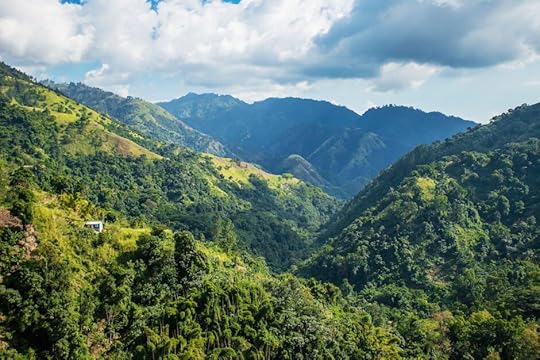
Photo: Photo Spirit/Shutterstock
The famed Blue Mountain is close enough to the capital to make it one of the most popular weekend trips in Jamaica, but this picturesque corner of the country deserves a few days to take it all in. The UNESCO-listed Blue and John Crow Mountains National Park (BJCMNP) spans 4 parishes — St Andrew, St Thomas, Portland, and St Mary. The region is loved for its biodiversity which includes 200 species of resident and migrant birds and more than 800 species of endemic plants. Bird lovers will love exploring this region because it is one of the largest migratory bird habitats in the Caribbean. Ecclesdown and Hardwar Gap in the Blue Mountains are two prime locations to view much of the island’s tropical scene, including the largest butterfly in the western hemisphere, the giant swallowtail.
It’s also the home of Blue Mountain Coffee, which thrives in the cool, misty upper reaches of the mountains. For coffee lovers, a day trip to the Blue Mountain Estate will be the perfect way to learn the history and process behind the world-renowned coffee.
Visit Reach Falls
Reach Falls is a beautiful waterfall that was discovered in the Montanne Forest by runaway slaves. The falls sit on over 4 hectares of lush greenery in the John Crow Mountains.
The attraction is open to visitors from Wednesdays to Sundays and public holidays from 8:30 AM to 4:30 PM. For non-resident visitors over 12 years old, the cost to visit is $10 and Uc$5 for visitors ages four to 12.
This entrance fee includes a 30-minute tour of the property and ends with an exploration of the waterfall which also boasts a river pool, underwater cave, and a naturally formed heart-shaped jacuzzi.
Head to Frenchman’s Cove
Beaches in Portland, Jamaica, are known for their coves and lagoons — and Frenchman’s Cove Beach is an exceptional example. Between the lagoons and waterfalls is a peaceful private beach just 20 minutes east of Port Antonio that is enveloped by the tropical biosphere that Portland is known for. This beach sits on a 45-acre property that also has a restaurant, yoga shala, and dedicated spaces for playing games. An early morning trip is best to avoid the crowds and truly enjoy the clear, warm waters. 
The post How to plan a trip to Portland, Jamaica’s underexplored eastern Parish appeared first on Matador Network.
September 3, 2021
This road trip will take you to Switzerland’s most beautiful UNESCO sites

While Switzerland is known for its majestic mountainous landscapes, the country’s natural assets are not the only attractions worth checking out. From the streets of Berne’s Old City to the modern architectural work of Le Corbusier, Switzerland is home to 12 UNESCO-listed sites that are as magnificent as they are diverse. And the best way to see them is on a road trip.
The Switzerland road trip itinerary below covers eight of the 12 UNESCO sites and takes you to each corner of the country. You’ll pass through regions that speak German, Italian, and French along the way, and be blown away by the small country’s immense beauty.
Abbey of St. Gall
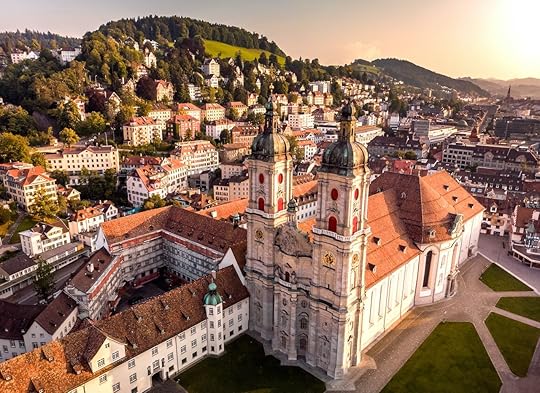
Photo: Ruslan Kalnitsky/Shutterstock
Your Switzerland road trip starts in the secluded northeastern town of St. Gallen. The itinerant Irish Monk Gallus was looking for a quiet retreat and built the abbey here in 612 CE. In the Middle Ages, the abbey became an influential center for religion and the arts, regularly attracting emperors and kings from the Carolingian and Ottoman courts. The Abbey Library and Cathedral are the highlights of the whole complex, with rich interiors. The site gained UNESCO status for its architectural influence and as a developing, continuous center of knowledge, religion, and culture.
Visiting the Abbey of St. Gall and Abbey Library could take up a big chunk of your day. But if you fancy spending more time in St. Gallen, you can wander around the charming old town or pop into the Textile Museum for a completely different vibe than the abbey.
Next on your Switzerland road trip, head to Benedictine Convent of St John Müstair, about a 3-hour drive from St. Gallen, with a stop at the scenic Burg Gutenberg in Balzers, Lichtenstein along the way. After you’ve taken in the breathtaking scenery of the little hilltop castle Burg Gutenberg, hop back on the E43 and continue to the Convent of St John at Müstair.
Benedictine Convent of St. John at Müstair
Photo: Stefano Cellai/Shutterstock
The legend goes that Charlemagne himself founded the Benedictine monastery of St. John around 775 CE. But it was more likely built under Charlemagne’s orders by the Bishop of Chur, for its strategic location. The monastery eventually became a convent, and the Convent of St. John at Müstair made it onto the UNESCO list because of the extensive, well-preserved frescoes inside the property’s church, which date back to the ninth century. The site has also hosted religious activities uninterrupted for almost 1,200 years, as nuns are still active in the convent to this day. Visit the Convent Museum, take a tour of the church and Chapel of the Holy Cross, and even book a night in the maiensäss (a former spring pasture hut) or the guesthouse.
Leave Müstair and start heading toward the Three Castles of Bellinzona, a 3.5-four-hour drive.
Three Castles of Bellinzona
Photo: Keitma/Shutterstock
The historic city of Bellinzona, the capital of the Italian-speaking canton Ticino, stands as a testament to medieval defensive architecture. The city’s strategic position called for fortifications, resulting in three castles — Castelgrande, Montebello, and Sasso Corbaro. The 15th-century fortifications made the UNESCO list for their impressive architecture and preservation. All three castles are open to visitors and the Castelgrande and Montebello are home to museums. When you’re done with the castles, tour the Bellinzona old city, and if you’re there on a Saturday, stop by the Bellinzona market for local food, wine, and crafts.
As you’ll be in the Italian-speaking part of Switzerland for this leg of the trip, it’s the perfect opportunity to grab some Italian food. Pizza Napoli has rave reviews from both locals and tourists, as does the classy Ristorante Locanda Orico. Both are within walking distance of the Montebello castle. Bellinzona also has places to stay with views of the castles, like the hostel Ostello Bellinzona or the sumptuous Hotel & SPA Internazionale.
When you’re done soaking up the history of Bellinzona, head south toward Monte San Giorgio, the next stop on your Switzerland road trip. The drive only takes an hour so you’ll have plenty of time to stop by the city of Lugano to see some of its sights. In Lugano, you can stroll down the waterfront of Lake Lugano, get some shopping done on Via Nassa, or relax at the lakeside Parco Civico.
Monte San Giorgio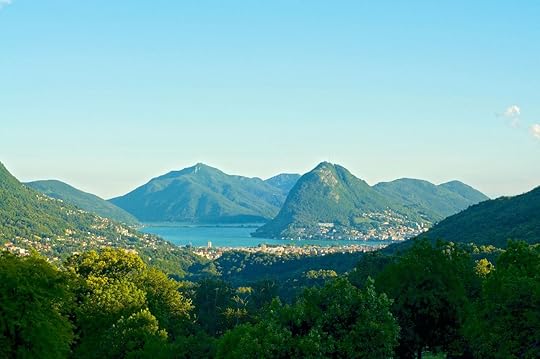
Photo: Marlon Trottmann/Shutterstock
Monte San Giorgio is one of Switzerland’s natural UNESCO sites, home to 240-million-year-old fossils of reptiles, fish, and plants. The wooded mountain beside Lake Lugano has the best fossil record of marine life from the Triassic Period, and visitors can view these fossils at the museum in Meride. You can also hike along either the geo-paleontological path or the cultural trail around Monte San Giorgio to learn more about the ancient sea basin that once existed there.
If you choose to stay the night near Monte San Giorgio, B&B La Crisalide in Meride has stunning countryside views. Alternatively, the Hotel Walter Au Lac in Lugano is highly rated and has beautiful lake views.
As you make your way toward Jungfrau-Aletsch, you can either take the southern route through Italy via the E62 or stay in Switzerland and use the A2.
Swiss Alps Jungfrau-Aletsch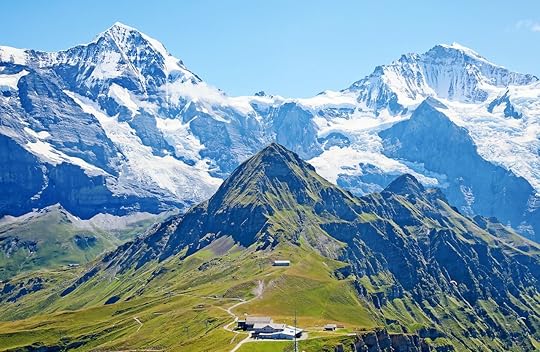
Photo: Fedor Selivanov/Shutterstock
Photo: https://www.shutterstock.com/fr/image...
It wouldn’t be right if the Swiss Alps didn’t make it onto the UNESCO list, and Jungfrau-Aletsch-Bietschhorn delivers. The region is home to Europe’s largest glacier. Although this entry is a Natural Heritage site, its exceptional landscapes are also recognized for inspiring European art, literature, mountaineering, and alpine tourism.
We recommend parking at Grengiols, a town on the southern edge of the glacier, then take a cable car to the mountain town of Bettmeralp. From Grengiols, you can also head to the World Nature Forum in Naters — only a 30-minute drive — and check out interactive exhibits about the World Heritage site. Reaching the “Top of Europe” at Jungfraujoch, on the northern edge of the glacier, may prove difficult by car but you can take a three-hour train from Naters. For the more adventurous, there’s also 15-stage hiking around the glacier.
You can choose to spend the night in Bettmeralp, in a chalet-style lodging like the Hotel Slalom or Hotel Bettmerhof. Naters and the neighboring town of Brig also have some nice places to stay, such as the swanky Hotel Ambassador Brig or the Hotel Adhhoc just across the street from the World Nature Forum.
If you depart from Brig, the Le Corbusier UNESCO site is only one to two hours away. On the way, you’ll pass through the town of Saint-Léonard, where you can take a subterranean boat ride on the Lac Souterrain (underground lake). It’s the biggest underground lake in Europe, and the site has 30-minute guided boat tours every day.
Architectural Work of Le Corbusier — Corseaux
Photo: Villa Le Lac Le Corbusier/Facebook
Corseaux is situated on Lake Geneva, and after you hit Villeneuve, your route will skirt along this massive lake. The towns and cities sitting on Lake Geneva are worth visiting before you get to Corseaux, especially Montreux and Vevey.
The Villa “Le Lac” by architect Le Corbusier is just outside Vevey, in the small town of Corseaux. It’s one of two buildings in Switzerland designed by Le Corbusier and one of 17 sites worldwide that make up the UNESCO listing. Le Corbusier’s work has UNESCO status for its contribution to the Modern Movement, which played an integral socio-cultural and historical role in the 20th century. The site is open for visits on Fridays, Saturdays, and Sundays.
Montreux, Vevey, and Corseaux all have waterfront restaurants serving up delicious seafood. Le Metropole in Montreux has outdoor seating that looks out on the lake, plus you can sample classic Swiss dishes. If you want to stay the night in the area, in a room with a lakeside view, then the super swanky Grand Hotel du Lac in Vevey should cut it. For a pared-down, less expensive option, there’s also the Hostellerie de Genève.
The first town to visit among the vineyard terraces is Saint-Saphorin, just a few minutes down the road from the Le Corbusier site.
Vineyard Terraces of Lavaux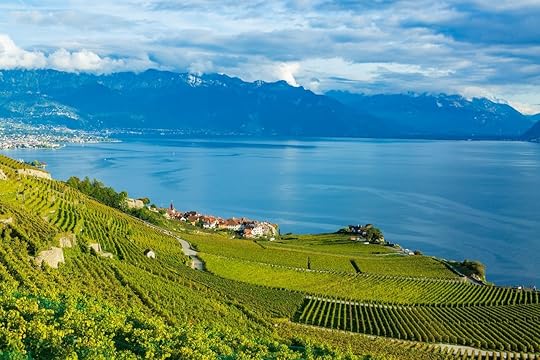
Photo: Michal Ludwiczak/Shutterstock
The ancient vineyards growing on the cliffs that buttress Lake Geneva cover 800 hectares. The best way to visit them is to park your car and hop on a train. The local train that starts at Vevey and runs to Puidoux has been dubbed the “Train des Vignes” because it gives you the best views of the vineyard terraces. You’ll want to get off at Chexbres, where you can embark on informational walks around the vineyards or hop on the tourist train-on-wheels “Lavaux-Panoramic” that goes from Chexbres through the various vineyard pathways. Several winemakers also open their wineries to visitors and share their process, including the Cave de Moratel.
The vines of Lavaux can be traced back to the 11th century. The well-preserved landscape and continuous adaptation of cultural traditions in winegrowing in the region make the vineyard terraces worthy of UNESCO status.
When you’re ready to head to the next site, head back to Vevey by train to retrieve your car, then make the one-hour drive to the Prehistoric Pile Dwellings Around the Alps.
Prehistoric Pile Dwellings Around the Alps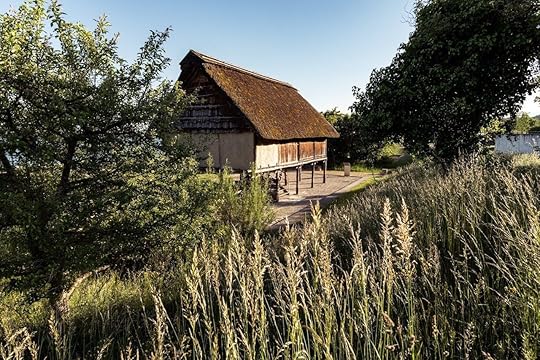
Photo: Latenium/Facebook
The UNESCO sites for the prehistoric pile dwellings are scattered across several cantons in Switzerland. The best ones to visit are on the shores of the Lac de Neuchâtel. Start with the Village Lacustre de Gletterens, which is open every day from May to October. Then, drive 30 minutes around the lake to Hauterive to see the Laténium Park and Museum of Archaeology. The museum has an exhibition about the lake dwellings in its permanent collection, and the archaeological park is a rebuilt Bronze Age pile dwelling that’s open year-round.
At each site, you’ll learn about conservation efforts for these pile dwellings and why they’re some of the most important archaeological sources for the study of European societies between 5000 and 500 BCE.
If you’re looking to grab a bite in Hauterive, the Laténium Museum restaurant offers good food with a view of the lake. Restaurant Le Silex is one wharf over from the museum and has an outdoor patio. For a place to stay with an old-world vibe, head to Les Vieux Toits. The hotel is only a few minutes away from the museum.
From Hauterive, it’s about a 40-minute drive to the center of Bern, where the Old City is located. Bern is the last stop on your Switzerland road trip.
Old City of Bern
Photo: MarinaD_37/Shutterstock
Bern’s Old City is a clash of architectural styles dating from various points in the city’s long history, which stretches back to the 12th century. It got UNESCO status for its exceptional planning and well-defined urban structures, which you’ll notice as you amble along the wide streets and underneath the arcades. The Old City is also full of shops — including a few places to buy a Swiss watch. On the edge of Bern’s Old City is the Zytglogge, the medieval mechanical clock tower and astrolabe.
Bern’s Old City is well worth exploring for a morning or an afternoon. You can grab a coffee or lunch at one of the many cafes or restaurants, like the cool underground bar the Old City Irish Pub, or the restaurant Krone for something more Swiss. Then, see the rest of the sights in Bern, like the Federal Parliament Building, the massive Cathedral of Bern, or cross to the other side of the Aare to visit the Alpines Museum of Switzerland.
The city also has a variety of places to stay, from chic hotels near the Old City like The Bristol to the quaint country-estate-like Bed & Kitchen am Tavelweg. 
The post This road trip will take you to Switzerland’s most beautiful UNESCO sites appeared first on Matador Network.
You can rent Chip and Joanna Gaines’ new Texas cottage on Airbnb
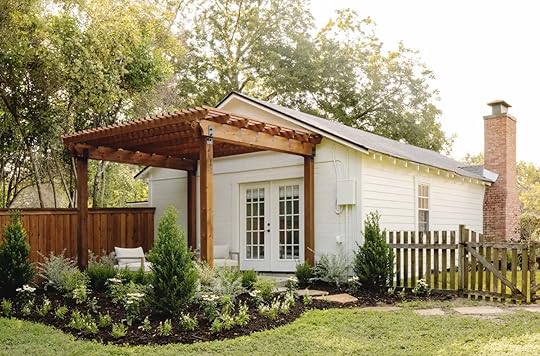
“Fixer Upper” couple, Chip and Joanna Gaines have opened the doors to their news quiet, charming cottage, dubbed Hillcrest Cottage, so you can rent it on Airbnb.
Hillcrest Cottage is owned by Chip and Joanna Gaines and was renovated and designed by the celebrity couple. The cottage is located in Waco, Texas, on Hillcrest Estate, and was once the carriage house for the estate.
This cottage has one bedroom, one bath, an office nook, and a private back patio. Hillcrest Cottage offers an open living, kitchen, and dining space, and there are French double doors that lead to the backyard and patio space.

Photo: Magnolia/Airbnb
The cottage comes with everything one would need for a weekend retreat, such as an indoor fireplace and a private, fully-fenced backyard.

Photo: Magnolia/Airbnb
Prices for weekday rates start at $395, and prices for weekend rates start at $495. Guests will also be charged a $20 cleaning fee, and for full-week bookings, there will be a 20 percent discount. The cottage is meant for only two guests.
Those looking to take advantage of this quaint, stylish cottage must act quickly because, in the past, both their B&B Magnolia House and Magnolia’s historic Hillcrest Estate property have booked up rapidly.
To reserve your stay at Hillcrest Cottage, check out the Airbnb listing. 
The post You can rent Chip and Joanna Gaines’ new Texas cottage on Airbnb appeared first on Matador Network.
Watch: This TikToker found a fossil worth $15,000 in Wyoming

oOne trip to Wyoming, and you’re on your way to becoming a paleontologist. The American Fossil dig in Kemmerer, Wyoming, is an open section of the South Dempsey Quarry and is the only place in the world that allows you to dig and keep every fossil you find.
The South Dempsey Quarry is located in the Green River Formation, which is in present-day Colorado, Utah, and Wyoming, according to the University of California, Berkeley’s Museum of Paleontology.
The top layer of rock in this quarry contains the most extensive record of fossilized freshwater fish in North America. Other finds including birds, mammals, plants, and reptiles.
Entertainer Danny Wolverton documented his dig on TikTok and found several 52 million-year-old fossils, including different fish and a rare bat worth $15,000. At the end, the video shows the slabs of rock containing the fossils being cut out so visitors can take them home.
@special_headGo to the American Fossil Quarry #fossilhunting #dinosaurs #fypシ #tiktoktravel #TalkCurlyToMe
♬ The Banjo Beat, Pt. 1 – Ricky Desktop
The cost of digging for fossils at the American Fossil dig starts at $39 for one hour. For a private full-day digging session, the price can go as high as $500. You can book your digging session online, or just walk in from 8 AM to 5 PM daily. But hurry! The season ends on September 30. 
The post Watch: This TikToker found a fossil worth $15,000 in Wyoming appeared first on Matador Network.
Everybody’s favorite Swedish band is back with a huge concert in London

ABBA, the most famous Swedish band in the world, is back.
After 40 years of absence, ABBA released the first two songs of their new album, “Voyage,” yesterday on YouTube. The songs, “I Still Have Faith in You” and “Don’t Shut me Down,” have garnered more than 5.3 million views and 2.3 million views, respectively, in less than 24 hours.
ABBA’s new album will have 10 brand new songs and will be released on November 5. ABBA’s last album, “The Visitors,” came out in 1981.
ABBA is the acronym from the first name of the members of the band: Agnetha Fältskog, Benny Andersson, Anni-Frid Lyngstad, and Björn Ulvaeus. All the members are now in their 70s — the perfect time for an epic reunion.
The pop band’s huge success in the 70s and 80s, with songs like “Waterloo” (winner of the Eurovision Song Contest in 1974), “Dancing Queen,” and “Mama Mia” (which inspired a Broadway musical and two movies).
The Swedish band also announced it will put on a hologram concert in 2022 in a custom-built arena at Queen Elizabeth Olympic Park in London. ABBA (in hologram form) will be accompanied by a 10-piece live band.

Photo: ABBA Voyage/Facebook
Tickets for ABBA’s concert go for sale on September 7, 2021, at 10 AM UK time (1 PM EST and 3 PM PST). You can register for pre-sale tickets here. 
The post Everybody’s favorite Swedish band is back with a huge concert in London appeared first on Matador Network.
You’ll soon be able to use your iPhone for your ID at airport security

Apple recently announced a new feature that gives iPhone users the opportunity to have a digital version of their license in Apple Wallet — and it’s one that works to get travelers through airport security.
People with Arizona and Georgia licenses are the first who are able to use the app, while people from Connecticut, Iowa, Kentucky, Maryland, Oklahoma, and Utah will follow next.
“We are excited that the TSA and so many states are already on board to help bring this to life for travelers across the country using only their iPhone and Apple Watch, and we are already in discussions with many more states as we’re working to offer this nationwide in the future,” Jennifer Bailey, Apple’s vice president of Apple Pay and Apple Wallet, said in a press release.

Photo: Apple
To use the feature, a driver’s license is added to the Wallet app similar to how a card is added: simply scan the driver’s license and complete a few additional security measures and it’s all set up.
This is great news for anyone who has a habit of forgetting their license when traveling, and it could be a trip saver for anyone who loses their ID or has their documents stolen. To use it to get past airport security, the user will present the digital ID and then verify with Face or Touch ID on their phone.
For those worried about the privacy and security implications, Apple announced that issuing states don’t know when or where users present their ID, and user identity will be protected against tampering and theft. If users misplaced their phones, they can use the “Find My Phone” app to locate it, lock it, and remotely erase the information.
This new ID feature will be available after an iPhone update later this fall. 
The post You’ll soon be able to use your iPhone for your ID at airport security appeared first on Matador Network.
Matador Network's Blog
- Matador Network's profile
- 6 followers



